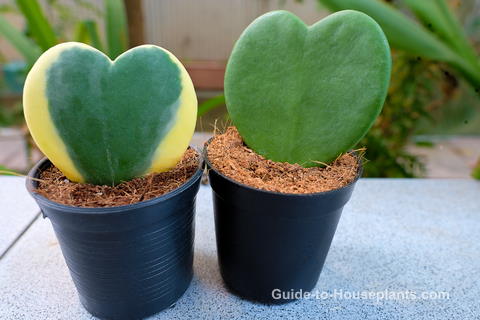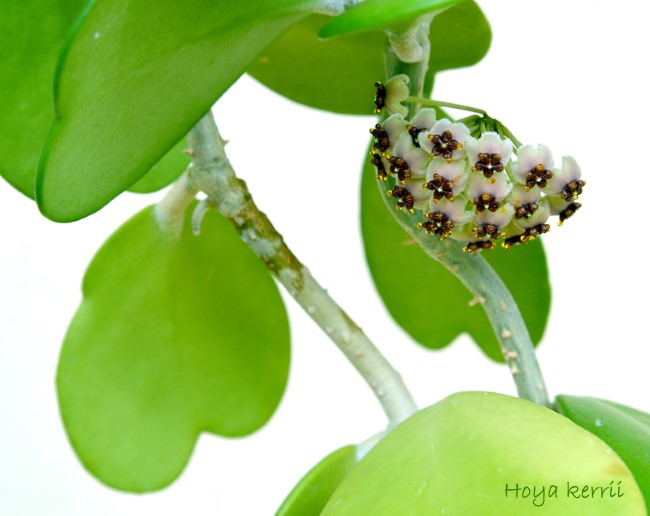How to Grow Hoya Kerrii Indoors
Botanical Name: Hoya Kerrii
This heart-shaped succulent is actually a vining plant -- when it grows up.
Slow-growing, it will take a few years to become a long vine studded with hearts. Mature vining plants will grow clusters of flowers in summer, when given plenty of sunlight. Typically pink with red star-shaped centers, they resemble the blooms of the popular Hoya carnosa.
 Hoya kerrii plants are often sold as single leafs in individual pots.
Hoya kerrii plants are often sold as single leafs in individual pots.Repot in spring, only when needed. This plant is so slow, it may stay in the same pot for years. When you pot up, use one that's only 1-2 inches larger. A container that's too large for the plant will hold too much water, which may lead to root rot.
Make it bloom. Hoyas may not bloom for a few years, so be patient. You can help it, though, by keeping it root-bound in a smallish pot. Give it several hours of bright, indirect sunlight each day in summer. Cooler nighttime temperatures can help, too. Just a 10° drop at night will do. After the flowers are spent, don't cut off the flower stem because it will likely bloom again.
Train your plant. Use florist wire or soft garden ties to support the vines on a trellis. You want to show off the captivating heart leaves, don't you? Or put them in a hanging basket to display them at eye-level.
The truth about your heart-leaf Hoya plant.
Hoya kerrii is usually sold as a single, potted leaf cutting. To grow into a vine, it needs part of a stem with a node attached. (A node is where the leaf is attached to the stem. It contains cells that will grow roots.) If your leaf cutting doesn't have the node attached, you'll enjoy it for several years. Just as it is. A heart-shaped leaf.
Buying Tips for Hoya Kerrii
Its unique heart shape makes it a popular novelty plant, sold as gifts for Valentine's Day. You may find it for sale as Valentine Hoya or Sweetheart Hoya. Hoya kerrii 'Variegata' has green and creamy white- or yellow-edged leaves. Buy one the size you want, otherwise you may wait years for it to grow into a large, vining plant.
 Umbels of porcelain-like flowers are similar to H. carnosa. Photo © Irina Borsuchenko
Umbels of porcelain-like flowers are similar to H. carnosa. Photo © Irina BorsuchenkoCaring for Hoya Kerrii Plant Indoors
Origin: Southeast Asia
Height: Stems can grow to 6 ft (1.8 m) or more.
Light: Bright, indirect light year-round. Don't have a sunny spot? Artificial grow lights work beautifully. Put your Hoya plant about 8 inches (20 cm) beneath the light and keep the lights on for about 14 hours a day. It's also important to give them darkness at night. Plants need a rest, too.
Water: Water thoroughly spring through fall, allowing potting mix to dry out a bit between waterings. This succulent won't tolerate soggy soil. Be sure to use a pot with drainage holes and empty the drainage tray. Use room-temperature water for your houseplants; cold water can shock them. In winter, water sparingly giving the plant just enough to keep the mix from drying out completely. Brown or wrinkled leaves indicate the plant is too dry.
Humidity: Give this tropical evergreen plant at least 40% relative humidity year-round. If your indoor air is dry in the winter months, boost the humidity with a cool-mist room humidifier. Keeping a humidity gauge near your houseplant will help; indoor humidity can drop drastically in winter, without our noticing it.
Temperature: Average to warm room temperatures (65-80°F/18-27°C) year-round. It will tolerate a minimum of 50°F/10°C. Keep Hoya kerrii out of drafts and away from heat/AC vents.
Soil: Grow in a good-quality, all-purpose potting mix
Fertilizer: Feed monthly spring through fall with a water-soluble fertilizer specially made for succulents, diluted by half.
Propagation: Take 3 in (7 cm) stem tip cuttings in spring. Cut just below a node (the place where a leaf is attached to the stem). The node contains cells that will grow roots. Cuttings should include at least 1 pair of leaves. They will root in moist potting mix. Remember, Hoya kerrii is slow-growing, so be patient.


